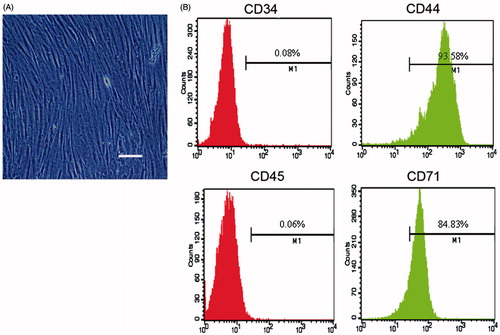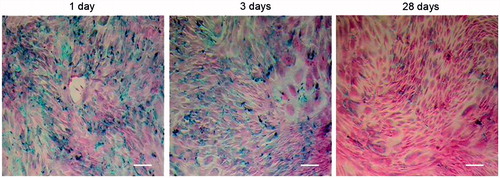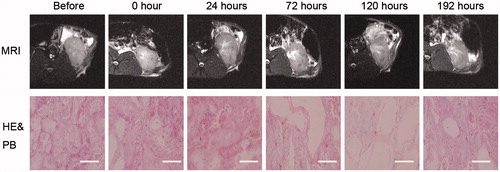Figures & data
Figure 1. (A) The morphology of rabbit BM-MSCs, Scale bar, 50 μm. (B) The phenotypes of BM-MSCs analysis by FCM at third passages. FCM analysis revealed that BM-MSCs were positive for CD44 and CD71 and negative for CD34 and CD45.

Figure 2. Prussian blue staining of SPIO labeled BM-MSCs, and the efficiency is up to 100%. Note: Scale bar, 50 μm.

Table 1. The average viability of SPIO-MSCs by Trypan blue staining test.
Figure 3. Detectable time point of labeled cells on MRI in vitro (T2*WI). Notes: An increasing signal intensity of labeled cells is suspended in gelatin. Number of labeled cells are suspended in 50 L gelatin. On the T2*WI, there is a significantly lower signal intensity in 5 × 104, cells/mL (A) and 5 × 105 cells/mL SPIO-MSCs compared with unlabeled counterparts, but the signal intensity of week 3 with 5 × 104 cells/mL and week 4 with 5 × 105 cells/mL is almost the same as that of control group.

Figure 4. Histological detection of labeled SPIO-MSCs in kidneys. Prussian blue and H&E stains of kidney after AKI and application of labeled SPIO-MSCs, all pictures showed a predominant presence of cells in the renal medulla corresponding to the regions of signal loss in MRI. The regions of signal intensity in MRI is the lowest at 72 h after SPIO-MSCs administration. The kidneys show more uptake of iron oxide particles in the renal medulla cells caused by uptake of circulating iron oxide particles, the Scale bar, 50 μm.


